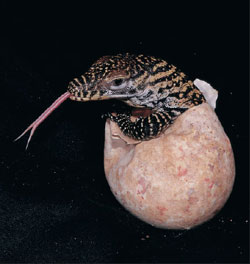Reptilian Groups

| Hatching Komode lizard. |
The amphibians, with well-developed legs, redesigned sensory and respiratory systems, and modifications of the postcranial skeleton for supporting the body in air, have made a notable conquest of land. But, with shell-less eggs and often gill-breathing larvae, their development remains hazardously tied to water. The lineage containing reptiles, birds, and mammals developed an egg that could be laid on land. This shelled egg, perhaps more than any other adaptation, unshackled the early reptiles from the aquatic environment by freeing the developmental process from dependence on aquatic or very moist terrestrial environments. In fact, the “pond-dwelling” stages were not eliminated but enclosed within a series of extraembryonic membranes that provided complete support for embryonic development. One membrane, the amnion, encloses a fluid-filled cavity, the “pond,” within which the developing embryo floats. Another membranous sac, the allantois, serves both as a respiratory surface and as a chamber for the storage of nitrogenous wastes. Enclosing these membranes is a third membrane, the chorion, through which oxygen and carbon dioxide freely pass. Finally, surrounding and protecting everything is a porous, parchmentlike or leathery shell.
With the last ties to aquatic reproduction severed, conquest of land by vertebrates was ensured. Paleozoic tetrapods that developed this reproductive pattern were the ancestors of a single, monophyletic assemblage called the Amniota, named after the innermost of the three extraembryonic membranes, the amnion. Before the end of the Paleozoic era amniotes had diverged into multiple lineages that gave rise to all the reptilian groups, the birds, and the mammals.
Members of the paraphyletic class Reptilia (rep-til´e-a) (L. repto, to creep) include the first truly terrestrial vertebrates. With nearly 7000 species (approximately 300 species in the United States and Canada) occupying a great variety of aquatic and terrestrial habitats, they are diverse and abundant. Nevertheless, reptiles are perhaps remembered best for what they once were, rather than for what they are now. The Age of Reptiles, which lasted for more than 165 million years, saw the appearance of a great radiation of reptilian lineages into a bewildering array of terrestrial and aquatic forms. Among these were herbivorous and carnivorous dinosaurs, many of huge stature and awesome appearance, that dominated animal life on land. Then, during a mass extinction at the end of the Mesozoic era, they suddenly declined. Among the few reptilian lineages to emerge from the Mesozoic extinction are today’s reptiles. One of these, the tuatara (Sphenodon) of New Zealand, is the sole survivor of a group that otherwise disappeared 100 million years ago. But others, especially the lizards and snakes, have radiated since the Mesozoic extinction into diverse and abundant groups. Understanding the 300-million-year-old history of reptile life on earth has been complicated by widespread convergent and parallel evolution among the many lineages and by large gaps in the fossil record.
Position in the Animal Kingdom
Modern reptilian groups comprise two of three lineages of amniote vertebrates that arose from amphibian-like tetrapods of the late Paleozoic era. The two reptilian lineages are the anapsid amniotes, represented by turtles, and the diapsid amniotes, represented by lizards, snakes, crocodilians, and tuataras. They are the survivors of an enormous radiation of Mesozoic amniotes, including the dinosaurs, most of which became extinct at the end of the Mesozoic. As traditionally defined, class Reptilia is a paraphyletic group because it excludes the birds, which are descendants of the common ancestor of the diapsid lineage. A third lineage of amniotes, the synapsids, gave rise to modern mammals.
Biological Contributions
- The shelled, amniotic egg that evolved with the earliest Paleozoic amniotes is supplied with extraembryonic membranes that provide a complete life-support system for the enclosed embryo. This innovation allowed amniotes to lay eggs on land. In some live-bearing reptiles the extraembryonic membranes are restructured into a placenta suggestive of and somewhat paralleling the evolution in the synapsid lineage of the more complex mammalian placenta.
- A tough, dry, heavily keratinized skin that provides protection against desiccation and injury. Scales in reptiles and feathers in birds arise as epidermal elevations overlying a nourishing dermal layer.
- Larger and stronger jaw muscles permit powerful jaw closure. Temporal openings in the diapsid skull provide space for bulging temporal muscles.
- Internal fertilization, with sperm introduced directly into the female reproductive tract with a copulatory organ.
- Effective adaptations for water conservation include a metanephric kidney that excretes nitrogenous wastes as uric acid. Such adaptations allowed reptiles (and birds) to occupy many terrestrial habitats.




